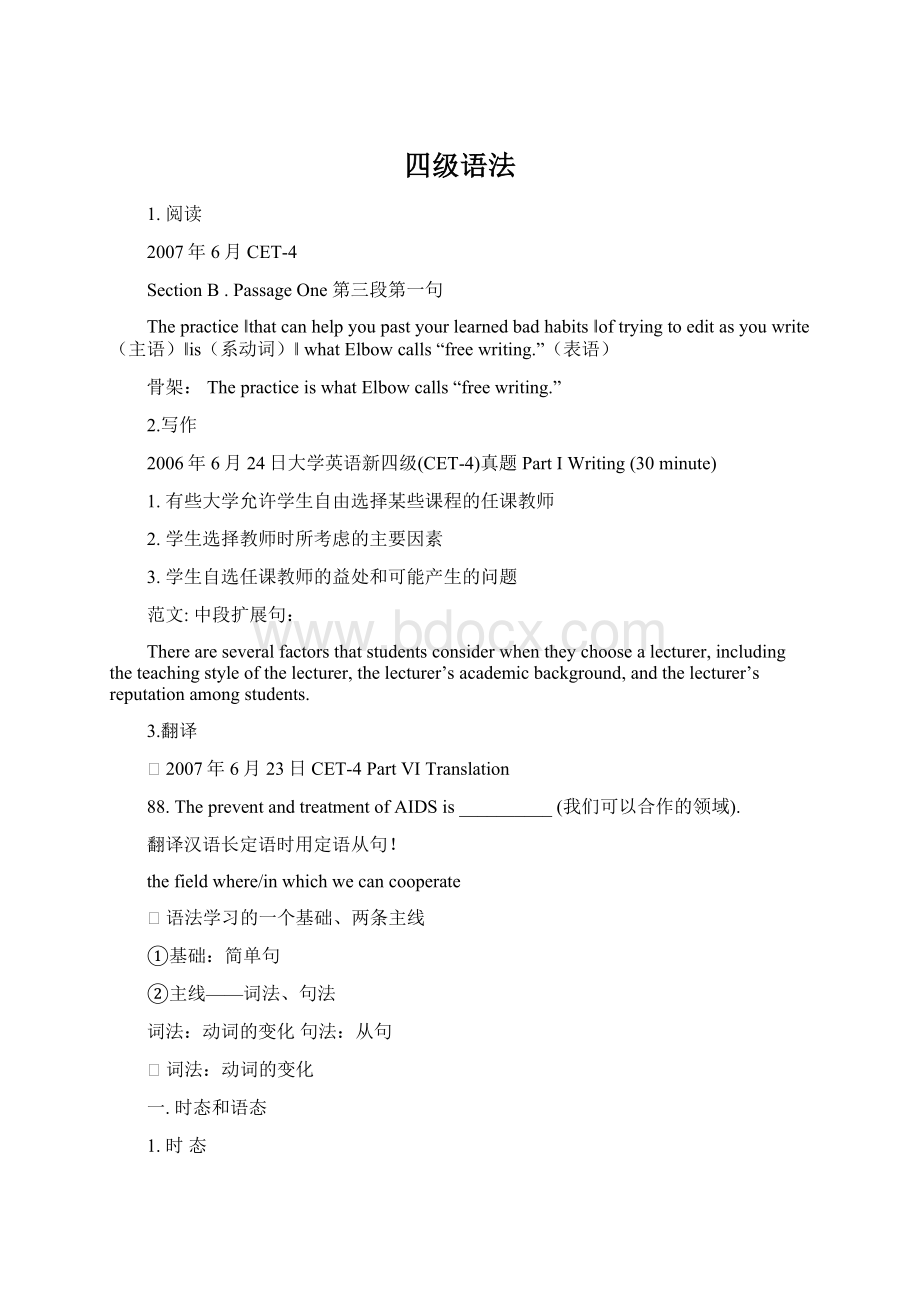 四级语法.docx
四级语法.docx
- 文档编号:6615821
- 上传时间:2023-01-08
- 格式:DOCX
- 页数:24
- 大小:41.56KB
四级语法.docx
《四级语法.docx》由会员分享,可在线阅读,更多相关《四级语法.docx(24页珍藏版)》请在冰豆网上搜索。

四级语法
1.阅读
2007年6月CET-4
SectionB.PassageOne第三段第一句
Thepractice‖thatcanhelpyoupastyourlearnedbadhabits‖oftryingtoeditasyouwrite(主语)‖is(系动词)‖whatElbowcalls“freewriting.”(表语)
骨架:
ThepracticeiswhatElbowcalls“freewriting.”
2.写作
2006年6月24日大学英语新四级(CET-4)真题PartIWriting(30minute)
1.有些大学允许学生自由选择某些课程的任课教师
2.学生选择教师时所考虑的主要因素
3.学生自选任课教师的益处和可能产生的问题
范文:
中段扩展句:
Thereareseveralfactorsthatstudentsconsiderwhentheychoosealecturer,includingtheteachingstyleofthelecturer,thelecturer’sacademicbackground,andthelecturer’sreputationamongstudents.
3.翻译
⏹2007年6月23日CET-4PartVITranslation
88.ThepreventandtreatmentofAIDSis__________(我们可以合作的领域).
翻译汉语长定语时用定语从句!
thefieldwhere/inwhichwecancooperate
⏹语法学习的一个基础、两条主线
①基础:
简单句
②主线——词法、句法
词法:
动词的变化句法:
从句
⏹词法:
动词的变化
一.时态和语态
1.时态
“时”分为四种:
过去时、现在时、将来时和过去将来时。
“态”分为四种:
一般状态、进行状态、完成状态和完成进行状态。
⏹时态主要反应在谓语动词上
一般
进行
完成
完成进行
现在
do/does
Bedoing.
Have/hasdone.
Havebeendoing
过去
Did
Was/weredoing.
Haddone.
Hadbeendoing
将来
Willdo.
Willbedoing.
Willhavedone.
Willhavebeendoing
过去将来
Woulddo.
Wouldbedoing
Wouldhavedone
Wouldhavebeendoing
⏹常考时态难点解析
(1)一般现在时:
(do/does)
①表示客观事实或真理
e.g1.Theearthmovesaroundthesun.
e.g2.Knowledgeispower.
②表示习惯性、常规性的重复动作
e.g.3.Classesbeginat08:
30inthemorning.
e.g.4.Jackalwaysgoestoschoolbybike.
(2)一般过去时(did)
①过去特定时间的动作或状态
Isawhiminthelibraryyesterdaymorning.
②过去的重复性动作
IwrotealetteronceaweektomyfamilywhenIwasinmyfirstcollegeyear.
Homemissing;Hardworking;FriendsMaking;Jobhunting
【注】一般现在时vs一般过去时
ThedogbitesXiaoQiang.见一次咬一次
ThedogbitXiaoQiang.曾经咬过
(3)现在完成时:
(have/has+done)
从过去一直延续到现在的动作和状态;强调过去的动作和状态对现在产生的影响和结果。
⏹常用的时间状语通常表示“一段时间”:
already,yet,never,以及since+点时间,
for/throughout/over/during+段时间;
e.g.IhaveworkedinthiscompanysinceIleftschool.
e.g.Throughouthistorymanhashadtoacceptthefactthatalllivingthingsmustdie.
【注1】主句的谓语动词一般是延续性动词;
如果是否定形式,主句的谓语动词可用瞬间动词。
【注2】一般过去时VS现在完成时
Shewasmygirlfriend.当爱已成往事
Shehasbeenmygirlfriend(fortwoyears)依旧你侬我侬
(4)过去完成时(had+done):
a)表示在过去某一时刻或动作以前完成了的动作,即“过去的过去”。
e.g:
Bynineo’clocklastnight,wehadgot200picturesfromthespaceship.
b)表示由过去的某一时刻开始,一直延续到过去另一时间的动作或状态
e.g.:
IhadstayedinAmericafor2yearsbeforeshemovedhere.
25.Beforethefirstnon-stopflightmadein1949,it____C____necessaryforallplanestolandforrefueling.
A)wouldbeB)hasbeenC)hadbeenD)wouldhavebeen
(5)现在完成进行时(havebeendoing)
动作或状态从过去某时开始,进行到现在,并将继续进行下去。
e.g.Thesepopfanshavebeenwaitingforthefamoussingerfornearlythreehoursinthecold.
【注】现在完成时VS现在完成进行时
当现在完成时中没有表示一段时间的状语,(since/for…),
仅表示一个完成了的动作而不继续。
Shehasslept.她睡完了(不困了)
Shehasbeensleeping.她一直在睡。
(6)一般将来完成时(shall/willhave+done)
(shall/willhave+done):
将来某时必定会发生的事.
IwillhavetaughtEnglishinNewOrientalSchoolforfiveyearsbytheendofnextmonth.
语态语态描述主语和谓语间的关系
语态分两种
1.主动语态主语是动作的发起者,称为主动语态;
Hecleansthewindow.
2.被动语态主语是动作的承受者,称为被动语态。
Thewindowiscleanedbyhim.
⏹动词的被动时态
一般
进行
完成
现在
am/is/aredone
am/is/arebeingdone
have/hasbeendone
过去
was/weredone
was/werebeingdone
Hadbeendone.
将来
Willbedone.
/
Willhavebeendone.
过去将来
Wouldbedone.
/
Wouldhavebeendone.
⏹动词主动时态变被动:
1.动词全部变成done
2.done前加be(形式随be前一个词而变)
⏹被动语态通式:
(以一般现在时为例)
动作承受者+am/is/aredone+by施动者
⏹2008年6月阅读SentionA
butIcouldhardly__claim___toknowmywayaroundthecontinent.Moreover,myknowledgeofforeignlanguageswas__48__toalittlecollegeFrench.
使用被动语态的目的
①实现句式结构的多样性
例:
2006年12月CET-4作文对春晚的态度
写句子:
越来越多的人,特别是年轻人质疑/挑战它(春晚)稳固的地位
a)越来越多的人Moreandmorepeople
Agrowingnumberofpeople更好~
b)它稳固的地位itsestablishedstatus
越来越多的人,特别是年轻人现在质疑/挑战它(春晚)稳固的地位
主动:
Agrowingnumberofpeople,especiallyyoungpeople,arechallengingitsestablishedstatus.
被动:
Itsestablishedstatusisbeingchallengedbyagrowingnumberofpeople,especiallybyyoungpeople.
②突出强调接受动作的一方(省略动作发出者逃避责任)
Ibrokethewindowthismorning.
Thewindowwasbrokenthismorning.
③施动者不明或没必要提
IwasborninTianjin.
ObamawaselectedasthepresidentofUSA(+bytheAmericanpeople)
91.Thoughaskilledworker,________(他被公司解雇了)lastweekbecauseoftheeconomiccrisis.(2006翻译)
时态?
一般过去时语态?
被动
hewasfiredbythecompany
二非谓语动词
1.不定式2.动名词3.分词
1.不定式
(1).不定式可以充当除谓语之外的其他任何成分
不定式的时态和语态:
四种形式
主动
被动
一般式
towrite
tobewritten
完成式
tohavewritten
tohavebeenwritten
进行式
tobewriting
一般不用
完成进行式
tohavebeenwriting
一般不用
⏹不定式一般式:
①不定式动作与谓语动作同时发生e.g.Iamgladtoseeyou.
②不定式动作在谓语动作之后发生(常见)e.g.WeplantogotoProvencethissummer.
⏹不定式完成式:
不定式动作比谓语动作先发生
eg.AlbertEinsteinisestimatedtohavehadtheincredibleintelligencequotient(IQ)of200.
(2).不定式的常考考点
①不定式作主语“it+todosth.”
写句子:
花钱比挣钱容易。
Spendmoneyiseasierthanmakemoney.
→Tospendmoneyiseasierthantomakemoney.
→Itiseasiertospendmoneythantomakemoney.
练习:
改错ThisisimpossibleforpeopletostaredirectlyattheSun.
ABC
A.错This改为It
②不定式作状语,主要表示目的和结果
(a)目的状语:
Toavoidcriticism(批评),
donothing,saynothing,benothing.
(b)结果状语:
onlyto+do引出意想不到或不愉快的结果(重要考点)
Wehurriedtotherailwaystation,onlytofindthetrainhadjustleft.
⏹③不定式作定语
(a)不定式一般作后置定语
(b)所修饰名词一般逻辑上作不定式宾语
e.g.Igavethekidacomictoread.
comicanimationcartoon(卡通)
(c)不定式作定语,介词不可以省。
e.g.IhavenopartnertospeakEnglishwith.
Ineedapentowritewith.
(3)不定式省略to的情况(考点)
①感官动词后不定式省略to
⏹see,watch,observe,notice,lookat,hear,listento,smell,taste,feel
⏹+do 表示动作的完整性,真实性;
Isawhimworkinthegardenyesterday.
⏹+doing表示动作的连续性,进行性
Isawhimworkinginthegardenyesterday.
注:
感官动词后面接形容词而不是副词:
Thecaketastesgood;Itfeelscomfortable.
②使役动词have/bid/make/let等词后不定式要省略to
eg:
I’dliketohaveleondoit.
注:
感官动词和使役动词变被动,需要还原to
eg:
Amanwasseentoentertheshop.
(4).后面只能跟不定式的动词
want,wish,hope,manage,promise,refuse,pretend,plan,offer,decide,agree,expect,begin,start,
allowsb.todo,causesb.todo,permitsb.todo,enablesb.todo,forcesb.todo,
bemorelikelytodo,lovetodo,warnsb.todo,beabletodo……
(5).有的时候to后面要接-ing形式
accustom(oneself)to;beaccustomedto;faceupto;inadditionto;lookforwardto;objectto;
bereducedto;resignoneselfto;beresignedto(托付给);resortto(诉诸于);sinkto;
beusedto;beclose/closenessto;bededication/dedicatedto(致力于);beopposition/opposedto;besimilarity/similarto.+doing
2.动名词
(1)动名词概述
①是名词
e.g.:
Seeingisbelieving.
②具有动词特征可以带宾语
e.g.:
Hatingpeopleislikeburningdownyourownhousetogetridofarat.
憎恨别人,就好像为了赶走一只老鼠,而把自己的房子烧掉。
(2)有些词后只能跟动名词
所有介词;appreciate;avoid;consider;tolerate;risk;permit;contemplate;defer;delay;deny;dislike;dispute;enjoy;escape;excuse;
feellike;finish;forgive;can'thelp;can’tstand;hinder;imagine;involve;keep;mention;mind;miss;postpone;practise;prevent;recall;report;regret;resist;suggest;understand...
另外还有一些接-ing形式的常用说法:
it'snogood;it'sno/little/hardlyanyuse;
it‘sworthwhile;spendmoney/time;there’snodenyingthefactthat(毋庸置疑…);
there’snopointin(干某事没有意义);there'snothingworsethan...
(3)动名词常见形式
一般形式:
IlikewatchingTV.
完成形式:
Iregretnothavingtakenyouradvice.
被动形式:
Thisquestionisfarfrombeingsettled.
(4)动名词常见考点
①动名词做主语谓语动词为单数e.g:
Seeingisbelieving.
②动名词的否定直接在其前加否定词e.g.Iregretnothavingtakenyouradvice.
③通过代词的宾格或所有格形式给出逻辑主语.
练习:
Doyoumind___C____asuggestion?
A.metomakeB.memakeC.memakingD.Imaking
④后面接动名词和动词不定式有区别的动词
a)Demand,deserve,need,require,want等动词后面,动名词主动形式表被动,相当于不定式的被动形式。
e.g.Heneedsencouraging.他需要被鼓励=Heneedstobeencouraged.
b)与remember,regret,stop,goon,prefer连用时,动名词表示发生在这些动词之前,不定式表示发生在这些动词之后。
remembertodo:
记得去做某事rememberdoing:
记得做过的某事
stoptodoStoptohavearest.stopdoing:
Imuststopsmoking.
goontodo:
继续去干另一件事goondoing:
继续干手头的事情
regrettodo:
后悔去做某事regretdoing:
后悔/遗憾做过某事
3.分词
(1)概述
分词相当于形容词或副词,在句中一般作定语或状语。
区别:
现在分词(doing):
表示主动进行;
过去分词(done):
表示被动过去状态;
e.g:
UnidentifiedFlyingObjects(UFO)
arespectedwriter
2)三种表被动的结构(考试重点)
⏹三种结构均作定语
①tobedone表将来(不定式)
②beingdone表进行
③done表过去或完成
e.g.1:
Ifthebuildingproject___A_____bytheendofthismonthisdelayed,theconstructioncompanywillbefined.(CET-4,2001.6,48)
A)tobecompletedB)iscompletedC)beingcompletedD)completed
(3)分词作状语
分词结构一定都作定语么?
状语
伴随关系Shecomesin,smilingatme.
如何区分分词结构是定语还是状语?
分词结构之前有无逗号!
一句话中同一主语发出多于一个的动作时,你选择其中一个动作作主要动作→谓语动词,其他几个动作作次要动作→分词结构。
①主语一致
采菊东篱下,悠然见南山
(陶渊明)采菊东篱下,(陶渊明)悠然见南山
Taopickedtheflower,seeingthesouthmountain.
Beingapopfan,LiYuchunisherfavorite.→Beingapopfan,shelikesLiYuchunmost.
__C__inthisway,thesituationdoesn’tseemsodisappointing.(CET-4,2000.1,68)
A.TolookatB.LookingatC.LookedatD.Tobelookedat
90.______(与我成长的地方相比),thistownismoreprosperousandexciting.(CET-4,2008.6,翻译)
答;Comparedwiththeplacewhere/inwhichIgrewup
补:
compare…to把...比作…ShallIcomparetheetoaSummer’sDay?
②主语不一致
有自己主语的独立分词结构—独立主格
e.g.Weatherpermitting,we’llbefishingtomorrow.
e.g.TheChinesewordfor“crisis”isdividedintotwocharacters,onemeaningdangerandtheothermeaningopportunity.
中文里“危机”分为两个字,一个意味着危险,另一个意味着机会。
e.g.Somanydirectors__B__,theboardmeetinghadtobeputoff.
A.wereabsentB.beingabsentC.beenabsentD.hadbeenabsent
选
【注】:
现在分词VS动名词
①动名词是动词的名词化,可视作名词,多数情况下属于句子的主干(主宾表);
②现在分词不是表伴随,就是作修饰(不是定语,就是状语),一般不是主干。
辨析:
现在分词作定语VS动名词作定语
现在分词作定语:
居多
①一般表示被修饰名词的行为状态
②通常具有进行时的意味
动名词作定语:
少
一般表示被修饰名词的用途,不含有进行时的意味。
e.g:
asleepingbag=abagusedfor
- 配套讲稿:
如PPT文件的首页显示word图标,表示该PPT已包含配套word讲稿。双击word图标可打开word文档。
- 特殊限制:
部分文档作品中含有的国旗、国徽等图片,仅作为作品整体效果示例展示,禁止商用。设计者仅对作品中独创性部分享有著作权。
- 关 键 词:
- 语法
 冰豆网所有资源均是用户自行上传分享,仅供网友学习交流,未经上传用户书面授权,请勿作他用。
冰豆网所有资源均是用户自行上传分享,仅供网友学习交流,未经上传用户书面授权,请勿作他用。


 对中国城市家庭的教育投资行为的理论和实证研究.docx
对中国城市家庭的教育投资行为的理论和实证研究.docx
